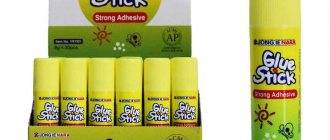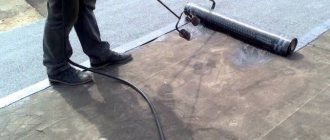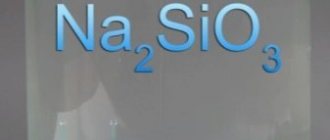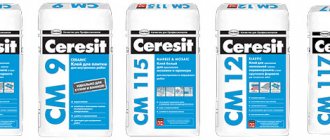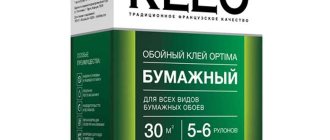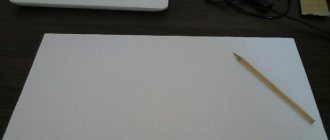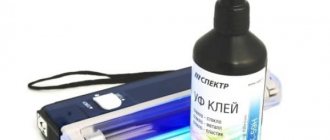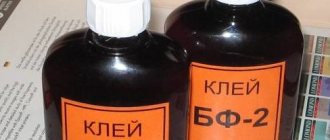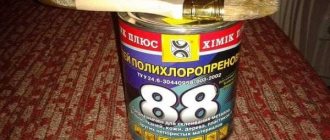Production technologies
Preparation of silicate glue is possible by:
- combinations of quartz sand and sodium bicarbonate (baking soda) followed by melting (firing) in a special container;
- processing silicate with potassium, sodium or lithium hydroxide in compliance with the temperature regime when the alkali solution boils.
The adhesive properties are due to the characteristics of the silicates themselves. They have increased adhesion when working with almost any surface.
Usage
Silicate is added to many building mixtures, where it provides them with greater strength. The glue also adds resistance to weather conditions and open fire. The mixture is also used to impregnate fabric materials and wood products.
Plant growers use this composition when pruning trees and treating wounds with it.
The glue can be used to prime brick, concrete or wooden surfaces. You can waterproof pools or other objects in contact with water. You can glue paper and glass, fabric, porcelain or leather products. Also used for interior renovation work.
This mixture can be combined with other materials. It can be used as a detergent or cleanser. Silicate glue is also used in industry, because it is a very good antiseptic, has an antifungal effect and protects against mold or mildew.
- First, mix the assembly adhesive well. Working with glue involves the use of brushes, brushes and rollers;
- First, the surface is cleaned of dust, dirt, and grease. Then it would be a good idea to sand everything down with sandpaper;
- It is applied by applying it to the surface. The parts to be glued are connected to each other;
- If you plan to prime the surface, first apply a tightening mixture of equal parts of cement and liquid glass. If a well is being dug, waterproofing is created by treating the walls of the well with glue. After glue is applied, the surface is treated with a solution of liquid glass, cement and sand;
- If it is necessary to prepare waterproof plaster, take sand and cement in a ratio of 2.5 to 1 and add glue (fifteen percent). In principle, the same recipe is used as a basis when constructing fireplaces, stoves and chimneys.
The mixture is used for aquarium breakdowns, for gluing glass and removing greasy and oily contaminants.
Advantages of silicate glue
Office glue has advantages when used.
This applies to:
- ease of use;
- durable connection of paper, wood, textiles, porcelain, leather and glass;
- connections of dissimilar surfaces and parts;
- deep penetration into the structure of materials, which means the composition releases moisture and a strong seam is formed;
- use as an impregnation;
- fire safety and heat resistance of the finished seam;
- increased thermal conductivity and resistance to sudden changes in temperature;
- absence of dangerous toxic components in the composition;
- waterproof;
- protection against corrosion (rust);
- penetration into the smallest cracks;
- the ability to further strengthen the structure itself.
The use of “miracle glue” in modern construction
The main consumers of the described material are considered to be enterprises in the construction industry. The use of liquid glass in concrete is widespread. Silicate glue is characterized by a relatively low cost. And at the same time, it significantly improves the performance properties of the concrete solution, guaranteeing the latter excellent waterproofing. In addition, liquid glass has high antibacterial capabilities.
Due to this, mold never appears on the concrete into which it is added, and fungus does not appear. All pools these days, as well as structures operating at constantly high humidity, are concreted with compounds containing the “miracle glue” we are considering.
It is worth taking into account that liquid glass hardens quite quickly. And in some cases it cannot be mixed with concrete before starting work.
The builders found a way out of this situation.
They use a “cunning” method, which involves treating an already erected concrete structure with a solution of water and liquid glass (the components of this mixture are taken in equal quantities). Silicate solutions are well suited for combating soil subsidence under erected buildings and structures. In this case, it is recommended to use liquid glass, the use of which does not require any large-scale work.
Surface treatment with liquid glass
When combating subsidence, silicate glue is pumped into the ground under construction according to one of two schemes:
- One-step method - a mixture of a special hardener and liquid glass is formed, which is supplied under the building.
- Sequential technique - glass is pumped in first, then the hardening compound.
Impregnation of plaster and wood with liquid silicate solutions is common (we will discuss this below). Silicate glue is also added to zinc silicate paint, which protects metal products from corrosion for 25–30 years! Liquid glass is also included in modern particle boards. Their impregnation with “miracle glue” makes any wood products durable and very resistant to compression.
Areas of use
Liquid glass glue is also used on an industrial scale. If in the office the composition is used to firmly bind paper, then in construction it is used to strengthen basic mixtures, for example, cement mortar for the foundation.
The use of glue depends on the components, for example:
- potassium silicate is necessary if the finished seam will be susceptible to environmental factors (changeable weather conditions) and chemicals;
- Sodium silicate provides fire resistance, it has antiseptic and antifungal properties.
Its use is relevant in mechanical engineering.
At home
The stationery composition is effective for treating burnt dishes and for cleaning frying pans. In schools and gardens, they create crafts from textiles, cardboard and natural materials (for example, leaves and twigs). Glue needed:
- to increase the waterproofing properties of coatings, for example, when treating bathrooms or swimming pools where there is constant contact with moisture;
- creating a glossy shine on fabrics and papers;
- effective stain removal with washing powders (added to their composition);
- coverings of home furniture, for example, a table or cabinet;
- protection of fresh tree cuts from fungal attack.
In combination with laundry soap and soda ash, stains and deposits are removed. To clean, you need to add everything to water and boil the dishes themselves (for example, a saucepan) in the solution. After using a home remedy for carbon deposits, all containers must be thoroughly rinsed under running water.
You can use glue in gardening to protect tree cuts from mold. It is considered a good antiseptic. It is used to glue ceramics and fix ceiling structures.
In construction
Treatment of building parts and mortars with silicate glue improves their technical characteristics.
It can be used:
- for mixing with heat-insulating compounds (withstands heating up to +1200°C);
- sealing cracks with plaster;
- adding to cement for accelerated hardening and drying (due to the formation of sodium aluminate);
- increasing the effectiveness of other adhesives;
- production of panels and ceramic products of light colors;
- increasing the heat-insulating properties of building materials and coatings (in foamed form);
- preparing a primer mixture with the addition of cement and water.
Silicate adhesive is additionally used to strengthen the foundation and protect surfaces that are constantly exposed to moisture and temperature changes. The resulting result is fire-resistant. By carefully treating the basement floors, you can protect the house from groundwater and make the surface itself more durable. When repairing a pipeline, the glue serves as a reliable sealant.
Other areas
On an industrial scale, the product is used for the manufacture of foundry molds and joining parts, for example, in mechanical construction. It is used to glue glass and treat surfaces as an antiseptic. It is also necessary when laying linoleum and caulking metal pipes. Glue-impregnated textile parts are fire-resistant. It is the best option for polishing countertops, shelves, floors and even cars.
In metallurgy, the product is used as a spray on welding electrodes.
Peculiarities
Silicate liquid glass glue usually has a transparent, dense consistency, sometimes with a yellowish or greenish tint. The sodium composition of the glue ensures good adhesion of the substance to any materials. It is used when working with foundations, glass, porcelain, and is used in fireproof processing of building materials.
Potassium glue is resistant to aggressive environmental factors and is used for the production of protective paints and varnishes. It lies on the surface in the form of a matte layer without glare.
Silicate glue is produced in accordance with GOST 13078-81, so to avoid purchasing counterfeits, you can ask the seller for a quality certificate. In its pure form, liquid glass can harden in 10 minutes. If it acts as an ingredient for another building mixture, then the curing time will vary.
If you mix sodium silicate adhesive with cement-sand compositions, the hardening speed will be increased. Therefore, such combinations are often used when working with foundations and to create waterproofing coatings. Stationery glue has a special composition that allows it to quickly penetrate the structure of solid materials, releasing moisture and increasing viscosity and density.
Types and brands
Office glue is made by different manufacturers and may differ in its composition. For example, the Oxium brand focuses on the production of soda glass adhesive. Silicate is the market leader. The Stekloproduct brand is more suitable for industrial purposes.
Adhesive compositions, in addition to silicate, also come in regular PVA or in the form of a glue stick. Such options are more often used in creativity.
Well-known manufacturers:
- Berlingo (Berlingo);
- Brauberg (Browberg);
- Erich Krause (Erich Krause);
- Attache;
- Elmers.
The only caveat of using silicate adhesives is the need to protect the skin. Therefore, it is better to stock up on protective rubber gloves in advance.
Manufacturers and reviews
Now you can find many quality products from various
This company produces sodium glass in accordance with GOST requirements. You can order from them absolutely any substance consisting of the necessary ingredients.
"Silicate"
Petersburg has long won a leading position in the domestic market. It produces silicate adhesive that is ideal for small repairs and large construction projects. It can be used in everyday life, when repairing garages, houses, apartments. It has a reasonable price, so it has won a large number of admirers.
"Stekloprodukt"
The Stekloprodukt organization produces foam glass, glass bottles and silicate glue. Liquid glass from this company has found its application in industry. The company produces only high-quality composition, which is regularly tested.
Packaging, packaging forms
Silicate-based adhesive compositions are sold in almost all office supply and construction stores. In the first case (Fig. 1) we can talk about convenient small jars with a dispenser, and in the second – about industrial volumes in the form of buckets and barrels of different capacities. Separately, you can purchase glue in the form of a dry powder, which must be diluted with cold water according to the instructions before use. There is also a solid form of glue in a rotating tube (pencil) and a spray.
Rice. 1
Alcohol
Alcohol is a solvent that can be useful for removing most adhesives. Due to its properties, alcohol will dissolve the adhesive components until they begin to peel off from the surface, as shown in the photo:
- Alcohol should be applied directly to the stain and wait until it begins to act;
- If the glue begins to succumb to the alcohol, you will notice it after a couple of minutes;
- After the alcohol has dissolved the adhesive stain, the surface must be cleaned and rinsed with water.
Specifications
Specifications refer to:
- versatility of use;
- creating a protective layer on any treated surface;
- the possibility of reducing the hardening time of the mixture;
- increasing the fire resistance of processed parts;
- long period of operation;
- antiseptic effect on parts;
- absence of harmful substances (toxins), which allows you to work in closed residential areas;
- long-term storage (about two years) without observing the temperature regime (both freezing and thawing of the composition are allowed);
- insulating properties of the coating.
| Characteristic | Description |
| Appearance | Transparent thick liquid with a possible yellow or green tint. |
| Consistency | Homogeneous. There may be sediment (does not affect the finished seam). |
| Density | 1.36-1.45 g/cm3 |
| How long does it take to dry? | On average, it takes no more than 20 minutes for the seam to completely harden. You need to work quickly and carefully. Once the office glue has completely hardened, nothing can be done with it. |
| Proportion of insoluble substances | 0,2% |
| Shelf life | 2 years provided the original packaging is hermetically sealed |
| Freezing and thawing the composition | Allowed, but the adhesive characteristics are not reduced |
| Permissible operating temperature of the finished seam | 1200-1300 °C above zero |
Manufacturers of CMC glue
In construction stores and markets there are Russian and imported TMs for sale. The price of the former is much lower, but the technical characteristics are not inferior.
Well-known manufacturers:
- Vympel 75V is produced in Russia. The finished solution has high viscosity and water-retaining properties. Suitable for all types of wallpaper on all surfaces, including metal. Without toxic substances, safe. Packing in bags.
- Karbocel produces a universal CMC product for all types of fabrics. This is an environmentally friendly product with high solubility. Highly effective product without fillers. Available in packages of 0.3 kg, 0.5 kg, 15 kg.
- Omega produces a carboxymethylcellulose-based adhesive with the addition of antifungal components. Suitable for various wallpapers in structure and width. The solution is prepared within three hours, resulting in a homogeneous mass without lumps. Shelf-life Unlimited.
- Polycell CMC-7 is a white fine-grained powder, highly soluble in water at any temperature. It is used in construction as a thickener for putties, increases the plasticization of solutions and the adhesion strength.
- Malva produces an adhesive designed for attaching multi-layer wallpaper (foam film), paper-based and fabric-based canvases. Fastening is carried out on painted, concrete, plastered, wooden surfaces.
Instructions for use
It is better to apply glue at home with a brush or spray.
Before gluing you must:
- clean surfaces from dust and grease accumulations;
- prime the parts by applying two layers of the composition (the second after the previous one has completely dried, without gaps or smudges);
- allow the primer coat to dry completely;
- Using a spatula, apply an even layer of liquid glass (protective clothing, goggles and gloves are required).
If a car body is polished with glue, the algorithm is as follows:
- clean and degrease surfaces;
- polish the surface to remove the old coating;
- smooth out all the flaws;
- carry out the coating with liquid glass in stages with 3-10 repetitions;
- Allow the result to dry completely (at least 8 hours).
The procedure seems simple, but requires skills and experience. It is better to trust such work to specialists.
The use of silicate mixtures by children is permitted only under adult supervision.
How to prepare the solution
The silicate product sold in stores has a fairly high price. Therefore, many are interested in how to make silicate glue themselves. This is quite possible if you know the basic technology.
First you need to prepare all the necessary components and tools:
- Bucket.
- Cement.
- Brush.
- Electric drill.
- Putty knife.
- Water.
- Fine-grained sand mixture.
- Personal protective equipment.
According to the instructions, you need to mix all the substances.
Important! The dry mixture must be diluted with cold water.
Depending on the base material, you need to select the optimal proportions for mixing. First of all, water is poured into the bucket, followed by cement. The resulting combination must be mixed well for complete dissolution. You can use a construction mixer for this. If a composition for waterproofing is needed, then sand, cement and silicate should be taken in equal proportions.
Not everyone knows that a fire-resistant mixture can also be prepared from silicate glue. The process includes the following stages: the cement-sand substance is diluted, then an adhesive mixture is added to it in an amount of 1/4 of the total mass.
Note! A fire-resistant mixture is necessary for finishing the surface of fireplaces and stoves.
At home, you can also create an antiseptic silicate solution that needs to be used to cover wooden surfaces. In this case, all components are mixed in a 1:1 ratio. It can be used for application to plaster and concrete.
How and with what to wash
Fresh stains from silicate glue can be successfully removed with a swab dipped in warm water. To remove glue from clothes, you can use baking soda. First, dissolve it in water, and then soak the fabric with the detected flaw in it for 10-15 minutes. It will not be possible to completely clean the glass from dried glue stains. Especially if they are outdated. This is due to the diffusion effect due to the similarity of the materials themselves. If you still take a chance, you can check whether the stain is removed by wetting it with a small amount of cologne or alcohol and setting it on fire. Under their influence, the glue should become softer. It can be scraped off with a blade and washed off with clean water.
You can remove glue from fabric only in a liquid consistency. After drying, any action is likely to ruin the item by creating a hole. It is also impossible to wipe off dried glue in any way.
Tips and tricks
When working with liquid glue, you should be guided by the following tips and recommendations from experienced craftsmen and specialists:
- The finished surface must be perfectly flat and smooth, without flaws.
- Avoid getting glue on exposed skin.
- After completion of construction and repair work, you need to carefully close the bottles and jars of glue in order to preserve the ability to use the product another time.
- To slow down the hardening period of the solution, you need to mix the composition in a different order. First add glue to the water, and only then cement and sand.
- Apply glue only to degreased and primed surfaces to increase the level of adhesion.
- It is necessary to prevent foreign particles from entering the composition so as not to disrupt adhesion.
- It is better to prepare the glue in small portions so that you have time to work with it before it completely hardens.
- After treatment with liquid glass, it is necessary to ensure that the surface remains motionless for a certain period. It will take at least a day to dry completely.
Using silicate glue (2 videos)
Silicate glue (15 photos)
Oil
If all the previous means are not suitable for cleaning the glue, then you can try to dissolve the stain using oil, vegetable or cosmetic for children:
- The stain should be thoroughly oiled;
- After it has stood for a while, you need to start rubbing it into the glue;
- If the oil works, you will notice how the glue dissolves and combines with the oil. Oil can dissolve most adhesives that are made on its basis;
- After the glue has dissolved in the oil, you need to remove what is left of the stain and wash the material with water, as shown in the photo.
How not to wipe off glue residue on glass
Before you find out how and with what to remove superglue from glass, it is recommended that you familiarize yourself with the list of cleaning products and tools that should never be used. Neglecting the rule will damage the surface of the glass, without the possibility of further restoration:
- Abrasive particles. In this case, we are talking not only about work equipment (sponges, brushes, etc.), but also about detergents. After processing, they will scratch the surface, deteriorating the appearance of the glass. Scratches can be removed, but the process is labor-intensive and sometimes costly.
- Damage to the glass surface will also be caused by any hard objects, such as metal sponges.
- If drops of glue have already hardened, then it is better to refrain from using acetone and solvent 646, since they often smear the adhesive mass on the glass rather than remove it. However, if the stain has just been placed and the glue has not had time to harden, you need to act immediately.
You should not resort to thermal effects on glass, mirrors and other fragile surfaces. If they are heated unevenly, they may crack.
Effective adhesive removers
There are several proven methods on how and how to remove instant glue from glass. If cleaning is carried out strictly following the instructions, then a positive result will not be long in coming.
Effective improvised means that will help remove drops of glue (superglue, PVA, stationery, etc.):
- ammonia;
- dishwashing liquid;
- petrol;
- vegetable oil;
- kerosene;
- liquid soap;
- solvent;
- White Spirit.
Acetone
In order to remove a glue stain with acetone, you will need a swab:
- the swab must be moistened in a liquid that is used for nail polish remover or acetone;
- then put it on the stain and wait 2-3 minutes;
- After the acetone has had its effect, you can remove the glue with a toothbrush.
Due to its properties, acetone can weaken the adhesive bonds between the material and the adhesive elements. This liquid removes almost all types of glue, and even super glue. If the material that is stained is synthetic, then it is better to first test the action of acetone on an area that is less noticeable, as it can harm some such materials.
